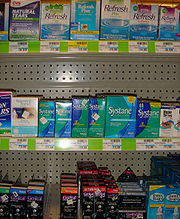
Artificial tear
Encyclopedia

Eye Drops
Eye Drops was a television program on TechTV that showcased short computer animation movies and clips made using off the shelf 3D animation software. The show claimed to showcase all different types of animation, but only a very small number of shorts featured non-CG animation...
used to treat the dryness and irritation associated with deficient tear production in keratoconjunctivitis sicca
Keratoconjunctivitis sicca
Keratoconjunctivitis sicca , also called keratitis sicca, xerophthalmia or dry eye syndrome is an eye disease caused by eye dryness, which, in turn, is caused by either decreased tear production or increased tear film evaporation. It is found in humans and some animals...
(dry eyes). They are also used to moisten contact lens
Contact lens
A contact lens, or simply contact, is a lens placed on the eye. They are considered medical devices and can be worn to correct vision, for cosmetic or therapeutic reasons. In 2004, it was estimated that 125 million people use contact lenses worldwide, including 28 to 38 million in the United...
es and in eye examinations.
Artificial tears are available over-the-counter
Over-the-counter drug
Over-the-counter drugs are medicines that may be sold directly to a consumer without a prescription from a healthcare professional, as compared to prescription drugs, which may be sold only to consumers possessing a valid prescription...
. Artificial tears are supplemented with other treatments in moderate to severe forms of dry eyes.
Chemistry
Preparations contain carboxymethyl celluloseCarboxymethyl cellulose
Carboxymethyl cellulose or cellulose gum is a cellulose derivative with carboxymethyl groups bound to some of the hydroxyl groups of the glucopyranose monomers that make up the cellulose backbone...
, hydroxypropyl methylcellulose
Hypromellose
Hypromellose , short for hydroxypropyl methylcellulose , is a semisynthetic, inert, viscoelastic polymer used as an ophthalmic lubricant, as well as an excipient and controlled-delivery component in oral medicaments, found in a variety of commercial products.As a food additive, hypromellose is an...
(a.k.a. HPMC or hypromellose), and hydroxypropyl cellulose
Hydroxypropyl cellulose
Hydroxypropyl cellulose is a derivative of cellulose with both water solubility and organic solubility. It is used as a topical ophthalmic protectant and lubricant.-Chemistry:...
. They contain water, salts and polymer
Polymer
A polymer is a large molecule composed of repeating structural units. These subunits are typically connected by covalent chemical bonds...
s but lack the proteins found in natural tears. Patients who use them more frequently than once every three hours should choose a brand without preservatives or one with special non-irritating preservatives.
Effects
Application of artificial tears every few hours can provide temporary relief from the symptoms of dry eyes.Hydroxypropyl cellulose stabilizes and thickens the precorneal tear film, and prolongs the tear film breakup time.
Usage
Artificial tears usually are the first line of treatment for dry eyes. While mild cases require application of lubricant drops four times a day, severe cases require more aggressive treatment, such as ten to twelve times a day. Thicker artificial tears can be used in severe cases, although these may temporarily blur vision.Precautions
Drops for red eyes can make the eyes even drier. If wearing contact lenses, rewetting or lubricating drops specifically for contact lenses should be used. Other types of drops may contain ingredients that damage the lens.Adverse effects, interactions and contraindications
Possible adverse effectsAdverse effect (medicine)
In medicine, an adverse effect is a harmful and undesired effect resulting from a medication or other intervention such as surgery.An adverse effect may be termed a "side effect", when judged to be secondary to a main or therapeutic effect. If it results from an unsuitable or incorrect dosage or...
of carboxymethyl cellulose and other similar lubricants include eye pain, irritation, continued redness, or vision changes. Use should be discontinued if any of them occur. Those of hydroxypropyl cellulose include hyperaemia
Hyperaemia
Hyperaemia or hyperemia describes the increase of blood flow to different tissues in the body. It can have medical implications, but is also a regulatory response, allowing change in blood supply to different tissues through vasodilation. Clinically, hyperaemia in tissues manifest as erythema,...
, photophobia
Photophobia
Photophobia is a symptom of abnormal intolerance to visual perception of light. As a medical symptom photophobia is not a morbid fear or phobia, but an experience of discomfort or pain to the eyes due to light exposure or by presence of actual physical photosensitivity of the eyes, though the term...
, stickiness of eyelashes, discomfort, and irritation. Long term use of preservatives present in some artificial tears may harm the eye.
Artificial tears have no reported interaction
Drug interaction
A drug interaction is a situation in which a substance affects the activity of a drug, i.e. the effects are increased or decreased, or they produce a new effect that neither produces on its own. Typically, interaction between drugs come to mind...
s. A documented contraindication
Contraindication
In medicine, a contraindication is a condition or factor that serves as a reason to withhold a certain medical treatment.Some contraindications are absolute, meaning that there are no reasonable circumstances for undertaking a course of action...
of artificial tears is hypersensitivity
Hypersensitivity
Hypersensitivity refers to undesirable reactions produced by the normal immune system, including allergies and autoimmunity. These reactions may be damaging, uncomfortable, or occasionally fatal. Hypersensitivity reactions require a pre-sensitized state of the host. The four-group classification...
.
Veterinary uses
Artificial tears are a part of the topical therapy for keratoconjunctivitis siccaKeratoconjunctivitis sicca
Keratoconjunctivitis sicca , also called keratitis sicca, xerophthalmia or dry eye syndrome is an eye disease caused by eye dryness, which, in turn, is caused by either decreased tear production or increased tear film evaporation. It is found in humans and some animals...
for animals such as dogs, cats and horses.

